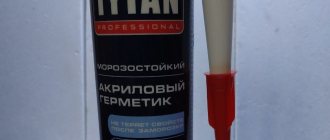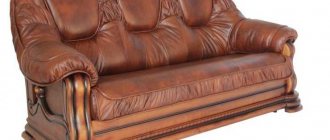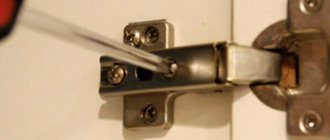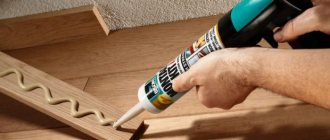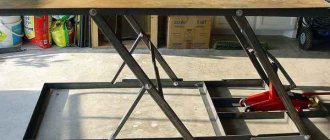Features and types
Such a gun cannot be called a complex device - in fact, it is a design for squeezing a sealing compound out of the container in which it is located. However, there are nuances in any matter, even in such a seemingly simple one. And based on these nuances, manufacturers offer tools for every wallet and for any purpose. Sealant guns can be divided into several categories according to the type of cartridge compartments, the features of the device and the method of supplying the sealant.
So, according to the type of compartments for cartridges (containers with sealant), these “peaceful” pistols can be divided into frame and sheet. The first ones are very popular among consumers because they hold the cartridge more tightly. Depending on the extrusion method, you will find cordless, pneumatic, electric and mechanical tools in stores. Each of them has its own advantages and disadvantages, so you need to choose depending on your goals.
What's good about cordless pistols is their autonomy - from the name it is clear that they operate from a battery pack, most often a lithium-ion one. Using a sensitive handle, the material is extruded, while the extrusion speed and feed accuracy can be adjusted using the same handle - the stronger the pressure, the more intense the work.
An electric gun differs from its battery-powered counterpart by and large only in the absence of a battery - the device runs on mains power. They apply sealant quickly and accurately, with a high degree of economy. Most often, these guns are used by construction professionals, because, in addition to convenience and autonomy, such pistols work with different types of cartridges. It is clear that such pleasure is not cheap, and for ordinary home use, for example, a small renovation in the bathroom, it is simply not advisable to buy this type.
Due to air pressure, a pneumatic type gun extrudes the material by pressing the handle. The design of such tools is often very ergonomic; manufacturers equip the tools with various stops and regulators, thanks to which you can obtain an even strip of sealant of the required thickness. Another good thing about the tool is the ability to work with different containers. It is advisable to use this type in medium and small construction, when the speed of work is not so important.
The most affordable and short-lived type of sealant guns is mechanical or manual. If we talk about everyday use, when you need to squeeze out 1-2 cartridges of material, this option is the most practical. But it will be difficult to work on large objects with such a tool, since squeezing out the mass is possible due to the physical effort of the hands, which reduces the accuracy and speed of work.
According to their design, pistols are divided into skeletal, semi-body and tubular. Skeletal ones are adapted for 310 ml cartridges. Semi-body instruments also work only with this volume, but have a simpler mechanism. Do not expect a long service life for such a tool - it is enough for 2-3 cartridges. And it will be quite uncomfortable to work with it - the rod squeezing out the mixture is quite tight, and besides, the tool tends to slip out of your hands every now and then.
It’s better to buy skeleton pistols - they are not much more expensive, but much more durable. The tubular type is capable of working with completely different cartridges, volumes from 600 to 1600 ml. Undoubtedly, such a tool will have to be refueled much less often.
Pneumatic, manual, network... - what else could there be a gun?
Now let's talk in more detail about the types and designs of sealant guns. So, simple manual mechanisms are considered the most primitive. In this case, it is enough to insert a bottle of sealant into the body, fix it there and, pressing the trigger handle, squeeze the required amount of substance into the seam. At the same time, you make a small effort.
The advantages of this model of sealant gun include its low cost. Its cost usually fluctuates around a few dollars. Thanks to its simple design, the mechanism turned out to be quite reliable. After all, such pistols consist of a metal body, a piston and a handle; there is simply nothing to break. The portability of the unit should also be noted. You don’t need to charge it, much less look for an outlet, and its compact dimensions allow you to take it absolutely anywhere.
However, such models are most suitable for small-volume work. But if you have a construction project, major repairs, or need a tool for professional work, then in this case it is better to give preference to more serious guns for sealant. They will not only significantly speed up the work, but also help save on material.
Next, let's talk about a pneumatic sealant gun. This unit is stationary, so it is advisable to purchase it to provide services in your own workshop. The principle of operation is as follows. After pressing the handle, air under pressure is automatically supplied from the compressor, due to which the pneumatic mechanism operates. The amount of air is regulated, and therefore the intensity of squeezing out the sealant. In this case, closed-type structures predominate.
The main advantages of a pneumatic machine are high seam accuracy and low material consumption. In addition, you will not need expensive batteries, as well as additional electricity costs. The pneumatic unit operates very quietly, easily and quickly. The power of this sealant gun is much greater than its battery-powered counterpart. The pneumatic mechanism is suitable for working with absolutely any consumable material. But the disadvantages include the high cost of such equipment, and the lack of portability. Not only can a pneumatic sealant gun not be taken to a site, it can even be difficult to move around the house.
Cordless sealant guns are also professional equipment. With such a device you can service a very large volume in the shortest possible time. The battery unit requires energy, but it is not the network that provides it, but a rechargeable battery. When you press on the handle, a piston and a small motor powered by a battery are activated.
The cordless tool is quite light, weight ranges from 1.3 kg to 2.5 kg. Therefore, it is quite possible to take it with you to any site, especially since one battery lasts approximately 90 minutes of continuous operation. During this time, you can easily process a huge area, and by purchasing another “spare”, you can generally operate the battery-powered device without interruptions, but this is no longer necessary for professional activities. The seams are applied efficiently and quickly, there can be no talk of any drips, which cannot be said about manual guns for sealant. In addition, by choosing a cordless tool, you can use both professional cartridges and film bags, while switching is instantaneous.
In general, a gun with batteries is an indispensable attribute for professional builders. There is no point in purchasing it for household purposes or for one-time repairs because of the very high cost. After all, even cheap versions of this model cost several hundred dollars, and the price of more expensive and high-quality ones generally exceeds a thousand conventional units. In addition, the operating pressure is lower than what a pneumatic or electric unit can produce.
And the last type is an electric pistol. From the name it already becomes clear that it operates from the network, which means, like any power tool, it is not mobile. Its effect is limited by the length of the cord, which is already a disadvantage. But still, such a tool has a number of advantages.
It has excellent power that lasts all the time because, unlike cordless caulking guns, there is nothing to discharge. That is why the seams are uniform, precise and beautiful along the entire length. The consumption of the sealant itself is minimal, so the equipment is economical. The device weighs less than a battery-powered one, and its cost is several times lower - for a few hundred dollars you can buy the best model that works with both hard cartridges and soft tubes.
Construction gun for sealant - selection instructions
Of course, the main factor in choosing a tool should be the amount of work to be done. Let's say, if all you need to do is process only a couple of joints when installing a tray in the bathroom, then a skeleton tool will be enough. If the task is more complex, for example, to carry out repairs in an entire apartment or house, then it is better to purchase a tubular pneumatic gun.
When time and precision of work are valued, it is necessary to provide yourself with an electric or battery-powered tool. When purchasing, pay attention to how comfortable such a device is for you, how it feels in your hand, and whether its elements interfere with operation. Pay special attention to the trigger, how tightly it is held and what material it is made of. It would be better if it was aluminum. As for brands, of course, it is better to pay attention first of all to trusted manufacturers who have earned the trust of consumers.
Scope of application
Since the tool is designed to work with sealant, it is clear from the name that it will be used to seal various seams and irregularities from the entry of ambient air, moisture particles and dust. Using a gun, you can also level out various defects in the surfaces of materials and structures that arise from poor quality work. Therefore, such a tool is indispensable for professional construction teams performing finishing and installation work. It will also be useful for home repairs for a skilled owner.
How to operate a pistol - simple steps
How to work with a pistol - this question is relevant not only for novice craftsmen, but also for any person who first encountered this tool. In fact, there are no difficulties - just a few nuances, after studying which all questions will disappear.
So, the principle of operation of sealant guns is quite simple - due to mechanical pressure on a container with sealant (or other material, for example, liquid nails), the material is extruded in the form of a strip, by directing which we achieve the desired effect. The pressure is provided by the rod, which is set in motion by pressing the trigger - apparently, this is why the tool got such a militant name. In pneumatic tools, instead of a rod, the pressure is exerted by air. Basically, difficulties arise when you need to equip the tool with the material itself, the same sealant. Fortunately, manufacturers try to adhere to the same standards, which makes our task much easier.
What will your pistol look like?
Of course, depending on the manufacturer, the characteristics of the device may differ slightly, but we will consider an average version of a pistol popular for private use. It is not difficult to guess that this is not pneumatic or mains, but battery-powered. Basically, such models are equipped with a speed shift control. For example, the Ryobi CCG1801MHG pistol has two feed speeds - maximum (5.5 mm/sec) and minimum (1 mm/sec). The electronic switch is equipped with special protection that automatically protects the device from overloads. The volume of cheaper models is 310 ml, while in expensive ones this characteristic is adjustable and reaches 600 ml. The battery capacity is 2.6 A/h, and the pushing force is 2900 N. The voltage can be 12 V and 18 V.
The package must include a charger, an instruction manual and a warranty card. Also, check that the tube and cartridge holders are included. Basically, only one battery is included, but there is no problem ordering another battery, and then you can work without interruptions for recharging - however, such a need is very rare. The dimensions of such devices are quite compact, the length is within 70 cm, and the height is about 30 cm. The weight can differ by half, however, the weight of the heaviest models is no more than 3 kg. It is worth noting that the lighter the device, the higher its cost.
How to work with a pistol - step-by-step diagram
Step 1: Remove the limiters
If we are dealing with a skeletal or semi-corpus instrument, the procedure will not take much time. First of all, you need to check whether the tube with the material is equipped with a special restrictive bottom. If it is present, it must be removed.
Step 2: Pull out the stem
In the gun we need to pull out the rod, for which we press the lever all the way and remove the part. We insert the cartridge into the vacant space and lightly press the trigger several times to strengthen the cartridge.
Step 3: Release the sealant
We make a hole in the cartridge through which the sealant will flow to the cone, giving us an even line of equal thickness.
Cones often come sealed, that is, we need to cut off the tip of the cone to get the required diameter of the sealant seam, but the cut should be slightly smaller than the diameter we need. If you decide to use a “syringe” or tubular gun, then the principle of filling it is somewhat different. To begin, make a hole in the cartridge with the material, or, if it is sealant or “sausage” packaged in bags, carefully cut off one corner or end so that the sealant can freely come out of the bag. You need to place the prepared container into the “syringe” itself in such a way that the cut end of the container is directed towards the tip through which the strip of sealant will come out. Of course, before inserting, remove the rod - this is done in the same way as in the case of the skeletal apparatus.
Usually the gun comes with several nozzles with tips, one of which we use to tighten the cylinder. If there is no hole in the tip, cut a small piece with a regular utility knife at a 45° angle. Of course, try to guess the diameter of the resulting hole. In any case, if there is a construction gun for sealant, there should also be instructions from the manufacturer. It’s not a sin to study it, because manufacturers can supply pistols with their own special developments and innovations that are not provided in standard versions.
Description of the tool
The construction tool got its name due to the method of supplying the mixture. Due to the pressure of compressed air, the mixture is pushed out of the nozzle of the gun. This effect is achieved by mechanically pressing the so-called trigger. Compositions such as liquid nails, various mastics and similar liquids can be used as a filling mixture for the gun. Structurally, the tool consists of the following main parts:
- The tip from which the mixture falls onto the work surface.
- Tool body.
- A spring that pushes the rod and provides uniform pressure on the composition inside.
- Pusher.
- Directly the handle and lever, with the help of which all working manipulations are performed.
Before work, you should prepare the gun. In soft packaging, the manufacturer configures it to work with sealants. To work with compounds in rigid packaging, you must reinstall the piston, which was initially installed from plastic.
First you need to unscrew the housing. Holding the rod handle, unscrew the plastic piston without touching the metal one. Next, you need to remove the nut from the plastic piston seat. After this, screw the nut three turns, making sure that the rod does not protrude beyond its plane. Use another nut to secure the exact location of the metal piston.
How to use a sealant gun - instructions for a beginner
Actually, you shouldn’t have any difficulties with a properly equipped pistol. If you followed the cartridge installation instructions above, you've already done everything you need to get started. So all that remains is to gently pull the trigger and move the sealant along the seam. If you use a skeletal or semi-body instrument, there may be several first presses to squeeze out the required amount of sealant to fill the void in the cap itself, then the presses should be done smoothly and unhurriedly.
With electric or cordless tools, pulling the trigger controls the rate at which the caulk is applied, so if this is your first time using such a tool, start in inconspicuous areas, such as caulking a seam in the far corner of a room. Once you get the hang of it, start working on prominent places. If you need to trim or press caulk into a gap, wet your fingers with water and run it across the surface in one smooth motion. There is no additional need to dry the material - in the open air it acquires the desired hardness within a few hours.
- Author: Manager Andrey
Rate this article:
- 5
- 4
- 3
- 2
- 1
(6 votes, average: 3.8 out of 5)
Share with your friends!
Modern types of tools
Let's talk about the most progressive types of this tool today. There are only two of them: electric and battery pistols. We will briefly describe them later in the article.
The cordless gun is characterized by a high level of pressure of the supplied mixture. It can easily handle cartridges or film bags. In addition, the manufacturer provides an easy transition from one type of sealant to another. The battery used is standard: lithium-ion units, which have long proven themselves in operation. After the mixture is supplied to the working surface, no leaks are observed in such a gun, thanks to the timely return of the piston to its original position.
An electric gun differs from a battery gun in that it can receive power from a regular civilian electrical network. The design of the tool is the same as previous models. Preparing the pistol for operation is much simpler than its competitors. To do this, the technician should loosen the locknut and move the rod back all the way. After which the tube is installed in its place and securely fastened.
The model is capable of operating both from a 220 V network with a frequency of 50 Hz, and from a rechargeable battery. It is worth saying that it is not included in the tool kit, so you will have to purchase it separately. There are both closed and open models. Most buyers choose closed models for their ease of use. It's all about securely fixing the tube, which the open model cannot boast of.




